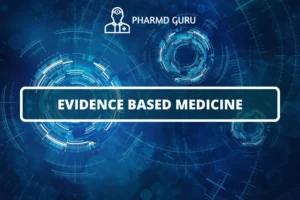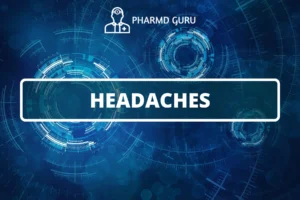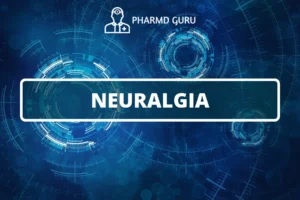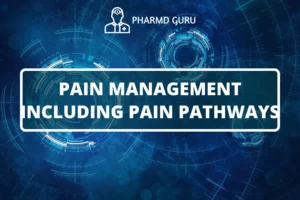Stroke is a medical emergency that occurs when the blood supply to the brain is disrupted, resulting in brain cell damage and potentially leading to long-term disability or even death. Understanding the etiopathogenesis, or underlying causes and mechanisms, of stroke is crucial for its prevention, early recognition, and effective management. In this article, we will explore the etiopathogenesis of stroke and discuss the pharmacotherapy options used in its treatment.
SCROLL DOWN TO THE BOTTOM OF THIS PAGE FOR ACTUAL NOTES.
Table of Contents
- Introduction
- Understanding Stroke
- Etiology of Stroke
- Pathophysiology of Stroke
- Clinical Features and Diagnosis
- Treatment Options
- Pharmacotherapy for Stroke
- Non-Pharmacological Approaches
- Lifestyle Modifications
1. Introduction
Stroke, often referred to as a “brain attack,” is a leading cause of death and long-term disability worldwide. It can occur suddenly and requires immediate medical attention. By understanding the etiopathogenesis and implementing appropriate treatment strategies, the impact of stroke can be minimized, and better outcomes can be achieved.
2. Understanding Stroke
Stroke occurs when the blood supply to the brain is interrupted or reduced, leading to the deprivation of oxygen and nutrients to brain cells. There are two main types of stroke:
- Ischemic stroke: This type of stroke occurs when a blood clot or plaque blocks a blood vessel in the brain, reducing blood flow.
- Hemorrhagic stroke: This type of stroke occurs when a blood vessel in the brain ruptures, causing bleeding and damage to surrounding tissues.
3. Etiology of Stroke
The etiology of stroke can be multifactorial, with various risk factors contributing to its occurrence. Some common risk factors include:
- Hypertension (high blood pressure): Uncontrolled hypertension is a significant risk factor for stroke.
- Atrial fibrillation: This heart rhythm disorder can lead to the formation of blood clots that can travel to the brain and cause a stroke.
- Diabetes: Individuals with diabetes have an increased risk of stroke due to associated vascular complications.
- Smoking: Tobacco use damages blood vessels and increases the risk of stroke.
- High cholesterol: Elevated levels of cholesterol contribute to the development of atherosclerosis, a condition characterized by the buildup of plaque in the arteries.
- Obesity: Being overweight or obese increases the risk of stroke.
- Sedentary lifestyle: Lack of physical activity and a sedentary lifestyle can contribute to the development of stroke risk factors such as hypertension and obesity.
4. Pathophysiology of Stroke
The pathophysiology of stroke involves the interruption of blood flow to the brain, leading to ischemia (lack of oxygen) and subsequent tissue damage. The exact mechanisms depend on the type of stroke:
- Ischemic stroke: In ischemic stroke, a blood clot or plaque blocks a blood vessel, resulting in reduced blood flow to a specific brain region. The lack of oxygen and nutrients leads to neuronal injury and cell death.
- Hemorrhagic stroke: In hemorrhagic stroke, a blood vessel in the brain ruptures, causing bleeding and the formation of a blood clot. The clot compresses brain tissue and disrupts normal blood flow, leading to tissue damage.
5. Clinical Features and Diagnosis
The clinical features of stroke vary depending on the affected brain region. Common symptoms of stroke include sudden-onset:
- Weakness or numbness on one side of the body
- Facial drooping
- Slurred speech or difficulty speaking
- Loss of coordination or balance
- Severe headache
Diagnosis of stroke involves a thorough medical history, physical examination, and imaging tests such as a computed tomography (CT) scan or magnetic resonance imaging (MRI). Time is critical in stroke diagnosis and treatment, as early intervention can minimize brain damage and improve outcomes.
6. Treatment Options
The management of stroke involves a multidisciplinary approach aimed at preserving brain function, preventing further damage, and reducing the risk of future strokes. Treatment options include:
- Acute stroke therapy: Ischemic strokes may be treated with clot-busting medications, such as tissue plasminogen activator (tPA), if administered within a specific time window. Mechanical thrombectomy, a procedure to remove the clot, may be performed in certain cases.
- Blood pressure management: Controlling hypertension is crucial in preventing recurrent strokes.
- Anticoagulation therapy: Individuals with atrial fibrillation may require anticoagulant medications to prevent blood clot formation.
- Antiplatelet therapy: Medications such as aspirin or clopidogrel may be prescribed to prevent clotting in certain cases.
- Rehabilitation: Stroke rehabilitation involves physical, occupational, and speech therapies to restore function and improve quality of life.
7. Pharmacotherapy for Stroke
Pharmacotherapy plays a vital role in stroke management. Medications commonly used in stroke treatment include:
- Antiplatelet agents: Drugs like aspirin, clopidogrel, or dipyridamole are often prescribed to reduce the risk of blood clot formation.
- Anticoagulants: Warfarin or direct oral anticoagulants (DOACs) may be used to prevent clotting in individuals with atrial fibrillation or other high-risk conditions.
- Statins: Statin medications help lower cholesterol levels, reducing the risk of atherosclerosis and stroke.
- Blood pressure medications: Various classes of medications, such as ACE inhibitors, beta-blockers, or diuretics, may be prescribed to manage hypertension and reduce the risk of stroke.
The choice of pharmacotherapy depends on individual patient factors, including the type of stroke, underlying conditions, and potential drug interactions. Close monitoring and regular follow-ups with healthcare professionals are necessary to optimize medication effectiveness and minimize adverse effects.
8. Non-Pharmacological Approaches
Non-pharmacological approaches are also crucial in stroke management and recovery. These may include:
- Rehabilitation therapy: Physical, occupational, and speech therapy can aid in regaining lost function and improving quality of life.
- Lifestyle modifications: Adopting a healthy lifestyle by engaging in regular physical activity, maintaining a balanced diet, managing weight, and avoiding tobacco use can reduce the risk of recurrent strokes.
- Support and counseling: Emotional support, counseling, and education for individuals and their caregivers can facilitate the recovery process and help cope with the challenges of stroke.
9. Lifestyle Modifications
In addition to medical interventions, certain lifestyle modifications can significantly contribute to stroke prevention and overall well-being. These include:
- Regular exercise: Engaging in moderate-intensity aerobic exercises, as recommended by healthcare professionals, can improve cardiovascular health and reduce stroke risk.
- Healthy diet: A balanced diet rich in fruits, vegetables, whole grains, lean proteins, and low in saturated fats and sodium promotes heart health and helps control risk factors such as hypertension and high cholesterol.
- Smoking cessation: Quitting smoking or avoiding tobacco use is crucial in reducing stroke risk and improving overall health.
- Limiting alcohol consumption: Excessive alcohol intake can increase blood pressure and contribute to stroke risk. It is important to consume alcohol in moderation or avoid it altogether.
ACTUAL NOTES:




